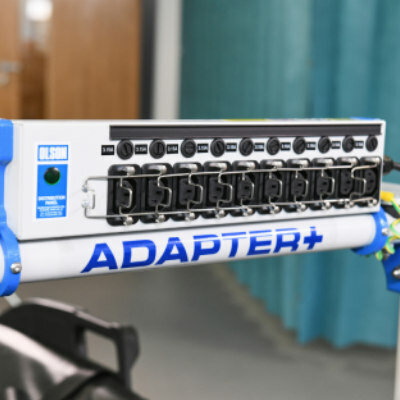Soft Artificial Heart Mimics Natural Form and Function
|
By HospiMedica International staff writers Posted on 25 Jul 2017 |

Image: A soft artificial heart made of silicon mimics natural function (Photo courtesy of ETH).
A completely soft, pneumatically driven artificial heart made of silicone elastomers beats almost like a human heart, according to a new study.
Developed by researchers at ETH Zurich (Switzerland) and Deutsches Herzzentrum Berlin (DHZB; Germany), the soft total artificial heart (sTAH) is similar in form to the human heart, but consists of only two ventricles, which are separated not by a septum but by an additional chamber that is inflated and deflated by pressurized air. The function of the inner chamber is to replace the muscle contractions of the natural human heart. The sTAH was created from silicone using a 3D-printed, lost-wax casting technique, and weighs 390 grams, with a volume of 679 cm3.
The sTAH was evaluated using a hybrid mock circulation model under various conditions, generating physiologically shaped signals of blood flow and pressures. When operated at 80 bpm, the soft heart achieved a blood flow of 2.2 L/min against an afterload systemic vascular resistance of 1.11 mm Hg, with mean pulmonary venous pressure fixed at 10 mm Hg. A resulting aortic pulse pressure of 35 mm Hg was measured, with a mean aortic pressure of 48 mm Hg. The study was published on July 10, 2017, in Artificial Organs.
“The soft artificial heart fundamentally works and moves in a similar way to a human heart. However, it still has one problem; it currently lasts for about only 3,000 beats, which corresponds to a lifetime of half to three quarters of an hour,” said study co-author Anastasios Petrou, MSc, a doctoral student at the ETH Product Development Group. “After that, the material can no longer withstand the strain. As a mechanical engineer, I would never have thought that I would ever hold a soft heart in my hands.”
A functional artificial heart remains one of the long-sought holy grails of modern medicine, as it would dramatically lower the need for heart transplants. But straightforward emulation of the anatomy of the human heart with synthetic materials is difficult due foreign-body rejection, the need for external power sources, and other complications that limit their lifespan and that of the human recipients.
Related Links:
ETH Zurich
Deutsches Herzzentrum Berlin
Developed by researchers at ETH Zurich (Switzerland) and Deutsches Herzzentrum Berlin (DHZB; Germany), the soft total artificial heart (sTAH) is similar in form to the human heart, but consists of only two ventricles, which are separated not by a septum but by an additional chamber that is inflated and deflated by pressurized air. The function of the inner chamber is to replace the muscle contractions of the natural human heart. The sTAH was created from silicone using a 3D-printed, lost-wax casting technique, and weighs 390 grams, with a volume of 679 cm3.
The sTAH was evaluated using a hybrid mock circulation model under various conditions, generating physiologically shaped signals of blood flow and pressures. When operated at 80 bpm, the soft heart achieved a blood flow of 2.2 L/min against an afterload systemic vascular resistance of 1.11 mm Hg, with mean pulmonary venous pressure fixed at 10 mm Hg. A resulting aortic pulse pressure of 35 mm Hg was measured, with a mean aortic pressure of 48 mm Hg. The study was published on July 10, 2017, in Artificial Organs.
“The soft artificial heart fundamentally works and moves in a similar way to a human heart. However, it still has one problem; it currently lasts for about only 3,000 beats, which corresponds to a lifetime of half to three quarters of an hour,” said study co-author Anastasios Petrou, MSc, a doctoral student at the ETH Product Development Group. “After that, the material can no longer withstand the strain. As a mechanical engineer, I would never have thought that I would ever hold a soft heart in my hands.”
A functional artificial heart remains one of the long-sought holy grails of modern medicine, as it would dramatically lower the need for heart transplants. But straightforward emulation of the anatomy of the human heart with synthetic materials is difficult due foreign-body rejection, the need for external power sources, and other complications that limit their lifespan and that of the human recipients.
Related Links:
ETH Zurich
Deutsches Herzzentrum Berlin
Latest Health IT News
- Machine Learning Model Improves Mortality Risk Prediction for Cardiac Surgery Patients
- Strategic Collaboration to Develop and Integrate Generative AI into Healthcare
- AI-Enabled Operating Rooms Solution Helps Hospitals Maximize Utilization and Unlock Capacity
- AI Predicts Pancreatic Cancer Three Years before Diagnosis from Patients’ Medical Records
- First Fully Autonomous Generative AI Personalized Medical Authorizations System Reduces Care Delay
- Electronic Health Records May Be Key to Improving Patient Care, Study Finds
- AI Trained for Specific Vocal Biomarkers Could Accurately Predict Coronary Artery Disease
- First-Ever AI Test for Early Diagnosis of Alzheimer’s to Be Expanded to Diagnosis of Parkinson’s Disease
- New Self-Learning AI-Based Algorithm Reads Electrocardiograms to Spot Unseen Signs of Heart Failure
- Autonomous Robot Performs COVID-19 Nasal Swab Tests

- Statistical Tool Predicts COVID-19 Peaks Worldwide
- Wireless-Controlled Soft Neural Implant Stimulates Brain Cells
- Tiny Polymer Stent Could Treat Pediatric Urethral Strictures
- Human Torso Simulator Helps Design Brace Innovations
- 3D Bioprinting Rebuilds the Human Heart
- Nanodrone Detects Toxic Gases in Hazardous Environments
Channels
Artificial Intelligence
view channel
AI-Powered Algorithm to Revolutionize Detection of Atrial Fibrillation
Atrial fibrillation (AFib), a condition characterized by an irregular and often rapid heart rate, is linked to increased risks of stroke and heart failure. This is because the irregular heartbeat in AFib... Read more
AI Diagnostic Tool Accurately Detects Valvular Disorders Often Missed by Doctors
Doctors generally use stethoscopes to listen for the characteristic lub-dub sounds made by heart valves opening and closing. They also listen for less prominent sounds that indicate problems with these valves.... Read moreCritical Care
view channel
Deep-Learning Model Predicts Arrhythmia 30 Minutes before Onset
Atrial fibrillation, the most common type of cardiac arrhythmia worldwide, affected approximately 59 million people in 2019. Characterized by an irregular and often rapid heart rate, atrial fibrillation... Read more
Breakthrough Technology Combines Detection and Treatment of Nerve-Related Disorders in Single Procedure
The peripheral nervous system (PNS) serves as the communication network that links the brain and spinal cord to every other part of the body. It consists of two parts: the somatic nervous system, which... Read moreSurgical Techniques
view channel
Hydrogel-Based Miniaturized Electric Generators to Power Biomedical Devices
The development of engineered devices that can harvest and convert the mechanical motion of the human body into electricity is essential for powering bioelectronic devices. This mechanoelectrical energy... Read moreWearable Technology Monitors and Analyzes Surgeons' Posture during Long Surgical Procedures
The physical strain associated with the static postures maintained by neurosurgeons during long operations can lead to fatigue and musculoskeletal problems. An objective assessment of surgical ergonomics... Read more.jpg)
Custom 3D-Printed Orthopedic Implants Transform Joint Replacement Surgery
The evolving field of 3D printing is revolutionizing orthopedics, especially for individuals requiring joint replacement surgeries where traditional implants fail to provide a solution. Although most people... Read more
Cutting-Edge Imaging Platform Detects Residual Breast Cancer Missed During Lumpectomy Surgery
Breast cancer is becoming increasingly common, with statistics indicating that 1 in 8 women will develop the disease in their lifetime. Lumpectomy remains the predominant surgical intervention for treating... Read morePatient Care
view channel
Surgical Capacity Optimization Solution Helps Hospitals Boost OR Utilization
An innovative solution has the capability to transform surgical capacity utilization by targeting the root cause of surgical block time inefficiencies. Fujitsu Limited’s (Tokyo, Japan) Surgical Capacity... Read more
Game-Changing Innovation in Surgical Instrument Sterilization Significantly Improves OR Throughput
A groundbreaking innovation enables hospitals to significantly improve instrument processing time and throughput in operating rooms (ORs) and sterile processing departments. Turbett Surgical, Inc.... Read more
Next Gen ICU Bed to Help Address Complex Critical Care Needs
As the critical care environment becomes increasingly demanding and complex due to evolving hospital needs, there is a pressing requirement for innovations that can facilitate patient recovery.... Read moreGroundbreaking AI-Powered UV-C Disinfection Technology Redefines Infection Control Landscape
Healthcare-associated infection (HCAI) is a widespread complication in healthcare management, posing a significant health risk due to its potential to increase patient morbidity and mortality, prolong... Read morePoint of Care
view channel
Critical Bleeding Management System to Help Hospitals Further Standardize Viscoelastic Testing
Surgical procedures are often accompanied by significant blood loss and the subsequent high likelihood of the need for allogeneic blood transfusions. These transfusions, while critical, are linked to various... Read more
Point of Care HIV Test Enables Early Infection Diagnosis for Infants
Early diagnosis and initiation of treatment are crucial for the survival of infants infected with HIV (human immunodeficiency virus). Without treatment, approximately 50% of infants who acquire HIV during... Read more
Whole Blood Rapid Test Aids Assessment of Concussion at Patient's Bedside
In the United States annually, approximately five million individuals seek emergency department care for traumatic brain injuries (TBIs), yet over half of those suspecting a concussion may never get it checked.... Read more
New Generation Glucose Hospital Meter System Ensures Accurate, Interference-Free and Safe Use
A new generation glucose hospital meter system now comes with several features that make hospital glucose testing easier and more secure while continuing to offer accuracy, freedom from interference, and... Read moreBusiness
view channel
Johnson & Johnson Acquires Cardiovascular Medical Device Company Shockwave Medical
Johnson & Johnson (New Brunswick, N.J., USA) and Shockwave Medical (Santa Clara, CA, USA) have entered into a definitive agreement under which Johnson & Johnson will acquire all of Shockwave’s... Read more
















